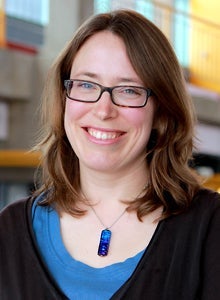When an election is held we often employ a peculiar kind of logic. As we mull over the candidates we may have a top choice, but if we think our preferred candidate isn’t going to win we might vote for our second choice. Or maybe we cast a ballot for our second choice because we want to make sure that a frontrunner who doesn’t represent our view loses.
This is an example of strategic voting and the phenomenon explored through mathematical analysis and simulation by David R. Cheriton School of Computer Science Professor Kate Larson and her recently graduated PhD student, Alan Tsang.
“We were interested in the effects of information in the context of strategic voting,” Larson says. “We explored this using a simple voting model — plurality voting that Canadians are familiar with. It’s the system where you cast a vote for a candidate and the winner of the election is the person who receives the most votes.”
The interesting twist is that Larson and Tsang developed a mathematical model that investigated the effects of limited information, in particular when voters get information from individuals in their social networks but not from the entire population. They then changed various properties of the network, including how closely connected people are and how information flows among them, to explore their outcomes.
It is perhaps not surprising that the more closely we associate with friends and colleagues who share a similar ideology, the more likely our view of the world is reinforced. This well-known property of social networks is called homophily — often called the echo chamber effect — and it is perhaps what’s behind the adage that birds of a feather flock together.
Larson and Tsang found through mathematical simulation that the more homophily in a social network — one in which people are more likely to be friends if they share preferences or if people are friends they are more likely to have common preferences — the lower the extent and benefit of strategic voting.
“We found this interesting disconnect,” she explained. “If the network had a high degree of homophily, we saw less strategization occurring and consequently ended up with worse outcomes for the entire population in the model. And if the network had less homophily, we saw more strategization but ended up with better outcomes.”
Their mathematical model assumed that a person would vote, then get information on how friends in their network had voted. Then, given that information, a person could change his or her mind on who to vote for.
“If I like candidate A best, but my friends are voting for candidate B, I change my mind and vote for candidate B,” Larson said. “I haven’t changed preferences. If I like candidate A best, I still do, but I now do not vote for this candidate given the information I have from friends in my network.”
This may seem an unusual way to picture real elections, but Larson and Tsang had good reason for their mathematical model to incorporate such iteration as a feature. “We envisioned this scenario as voters seeing the results of preliminary polls leading up to the main election, then that polling information changing how they will vote.”
When we think about social networks, we usually have close friends and colleagues in mind, but individuals also can be connected to news sources, Larson explained, adding that all sources of information and opinion could be treated as nodes in the network. “Our model considered news sources as just another connection, so in a highly homophilic network you would be more closely connected to various news sources, which are similarly aligned by worldview or preference.”
Their model may provide insight into why in real-world elections we see less strategic voting if a homophily of opinion is present. When voters are surrounded by friends, colleagues and news sources with similar views, it creates an echo chamber where they see their position as being more widely supported than it actually is. This may cause them to become further entrenched in their position and need a greater amount of conflicting evidence to change their minds.
“The echo chamber causes voters to have a harder time discerning if their position is in the minority and may prevent them from voting for a more strategic choice,” Larson said. “When surrounded by others with similar opinions, voters may not see an opportunity or even a need to strategize, which can lead to worse electoral outcomes for the entire population.”
About Kate Larson

David R. Cheriton School of Computer Science
Kate Larson is a Professor and the Associate Director of Undergraduate Studies at the David R. Cheriton School of Computer Science. Using mathematical models and artificial intelligence she investigates issues that arise when self-interested agents interact. Her research lies at the intersection of artificial intelligence, game theory, microeconomics and electoral behaviour.
The problems Dr. Larson explores centre on strategization — when is an individual going to be strategic in his or her decision making and how will strategization influence outcomes? She and her team of graduate students investigate how computational limitations influence strategic behaviour in a variety of multiagent systems and they develop approaches to overcome computational issues that arise when their models are applied to real-world problems. Their work informs a broad range of topical issues from electronic market design to understanding voting behaviour.
Professor Larson has a PhD in computer science from Carnegie Mellon University, an MS in computer science from Washington University, and a B Sci (Honours) in mathematics from Memorial University of Newfoundland. Her awards and honours include the Canadian Association of Computer Science’s Outstanding Young Researcher Prize (2015), the University of Waterloo Outstanding Performance Award (2015), a Cheriton Faculty Fellowship (2012–15), an Early Researcher Award (2006–11), and the University Medal for Academic Excellence (Mathematics, 1997).